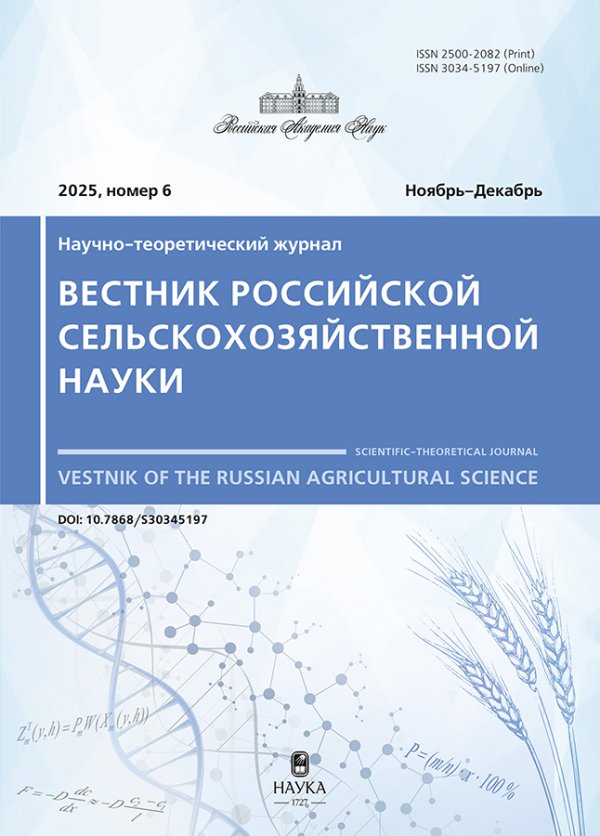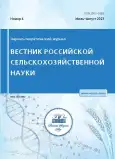Янтарная кислота в соболеводстве республики Саха (Якутия)
- Авторы: Черкашина А.Г.1
-
Учреждения:
- ФГБОУ ВО "Арктический государственный агротехнологический университет"
- Выпуск: № 4 (2023)
- Страницы: 90-92
- Раздел: Статьи
- URL: https://journals.rcsi.science/2500-2082/article/view/141517
- DOI: https://doi.org/10.31857/2500-2082/2023/4/90-92
- EDN: https://elibrary.ru/DOPRRP
- ID: 141517
Цитировать
Полный текст
Аннотация
Ключевые слова
Об авторах
Анна Георгиевна Черкашина
ФГБОУ ВО "Арктический государственный агротехнологический университет"
Email: ecag@mail.ru
Список литературы
- Балакирев Н.А. Кормление клеточных пушных зверей как фактор доместикации // Кролиководство и звероводство. 2019. №3. С. 4-7. doi: 10.24418/KIPZ.2019.3.001
- Балакирев Н.А., Перельдик Д.Н., Домский И.А. Содержание, кормление и болезни клеточных пушных зверей. СПб: Лань. 2013. 272 с. ISBN: 978-5-8114-1506-9
- Балакирев Н.А., Перельдик Д.Н. Кормление плотоядных пушных зверей. М.: КолосС, 2010. 191 с. ISBN: 978-5-9532-0791-1
- Балакирев Н.А., Шумилина Н.Н., Федорова О.И. и др. Соболеводство России: история, состояние и перспективы его развития // Ученые записки Казанской госуд. акад. ветеринар. медицины им. Н.Э. Баумана. 2022. Т. 251. №3. С. 20-27. doi: 10.31588/2413_4201_1883_3_251_20
- Балакирев Н.А., Юдин В.Н. Методические указания по применению научно-хозяйственных опытов. М.: РАСХН. 1994. 30 с. EDN: UIRGGR
- Бекенев В.А. Продуктивное долголетие животных, способы его прогнозирования и продления // Сельскохозяйственная биология. 2019. №4. Т. 54. С. 655-666. doi: 10.15389/agrobiology.2019.4.655rus
- Луговая И.С., Азарнова Т.О., Кочиш И.И. и др. Гистолого-биохимические аспекты сочетанного влияния некоторых естественных метаболитов на общую резистентность у яичных цыплят // Сельскохозяйственная биология. 2019. №2. Т. 54. С. 269-279. doi: 10.15389/agrobiology.2019.2.269rus
- Нормы кормления и нормативы затрат кормов для пушных зверей и кроликов: Справочное пособие / Н.А. Балакирев и др. Москва: РАСХН, 2007. 186 с. EDN: UDGMBH
- Протасов Б.И., Комиссаров И.М. Стратегия применения адаптогенов для стимуляции продуктивности у сельскохозяйственных животных // Сельскохозяйственная биология. 2012. Т.47. №6. С. 12-23. EDN: PIFXAD
- Фомичев Ю.П., Боголюбова Н.В., Некрасов Р.В. и др. Физиолого-биохимические эффекты двух кормовых антиоксидантов при моделировании технологического стресса у свиней (SUS SCROFA DOMESTICUS ERXLEBEN, 1777) // Сельскохозяйственная биология. 2020. №4. Т. 55. С. 750-769. doi: 10.15389/agrobiology.2020.4.750rus
- Черкашина А.Г. Сохранность соболей при введении в рацион адаптогенов в условиях ООО "Зверохозяйство Покровское" Республики Саха (Якутия )// Ветеринария и кормление. 2022. №4. С.61-64. doi: 10.30917/ATT-VK-1814-9588-2022-4-16
- Cheng Y., Quan W., Qu T. et al. Effects of Co-irradiation and superfine grinding wall disruption pretreatment on phenolic compounds in pine (Pinus yunnanensis) pollen and its antioxidant and α-glucosidase-inhibiting activities // Food Chemistry, 30 May, 2021. Vol. 345.
- Ivanova A.V., Gerasimova E.L., Gazizullina E.R. An integrated approach to the investigation of antioxidant properties by potentiometry // Analytika Chimika Acta on ScienceDirect, 15 May, 2020. PP. 83-91.
- Shazaib R.M., Yalçın S. Effects of supplemental pine needles powder (Pinus brutia) on growth performance, breast meat composition, and antioxidant status in broilers fed linseed oil-based diets// Poultry Science. 2020. V. 99. PP. 479-486.
- Welson N., Rofaeil R., Ahmed S. Vitamin E protects against gabapentin-induced chronic hepatic and renal damage associated with the inhibition of apoptosis and tissue injury in rats // Life sciences. 2021. V. 267. PP. 48-53.
Дополнительные файлы










